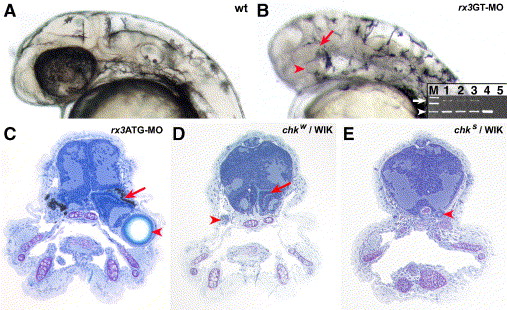Fig. 4 Phenocopy of the chk phenotype by morpholinos directed against rx3. The phenotype upon injection of the morpholinos rx3GT-MO (B) or rx3ATG-MO (C) into wt embryos phenocopies the chk phenotype, compared to buffer-injected controls (A). (A, B) 40 hpf embryos, (C) 9 dpf larvae. The highest effective doses were 200 μM for both rx3ATG-MO and rx3GT-MO. At these concentrations, the RPE is reduced or absent in the morpholino-injected embryos, but the NRs and the lenses (red arrows and arrowheads in panels E and G, respectively) are present. (B) A splicing defect in the mRNA of rx3 (white arrow) is observed upon rx3GT-MO injection as scored by RT-PCR. The aberrantly spliced product is 906 bp long, and the properly spliced mRNA (white arrowhead) is 514 bp long. M, molecular weight markers; 1, 2 and 3, RT-PCR products from a single embryo at 24 hpf, 30 hpf and 40 hpf respectively; 4, injected control at 40 hpf; 5, control without reverse transcriptase. The products in line 3 were obtained from the embryo in the photo. (D, E) chk phenotypes in the WIK background. The red arrows and arrowheads indicate the NR and the lenses, respectively. ATG-MO, morpholino designed against the translation initiation region; GT-MO, morpholino against one of the donor splice sites. See Fig. 1 for other abbreviations.
Reprinted from Developmental Biology, 288(2), Rojas-Munoz, A., Dahm, R., and Nüsslein-Volhard, C., chokh/rx3 specifies the retinal pigment epithelium fate independently of eye morphogenesis, 348-362, Copyright (2005) with permission from Elsevier. Full text @ Dev. Biol.

